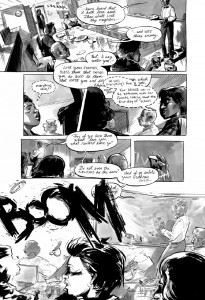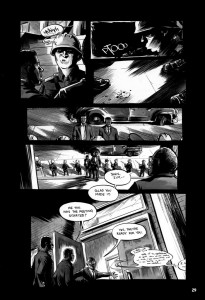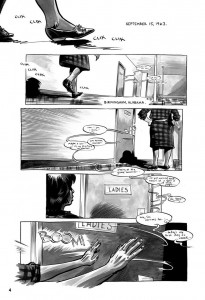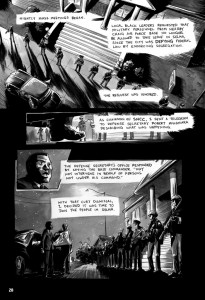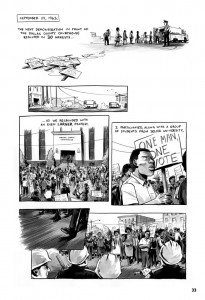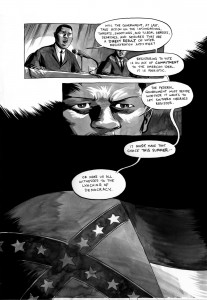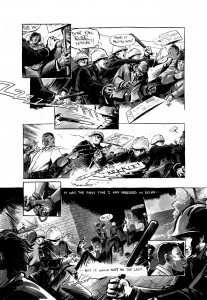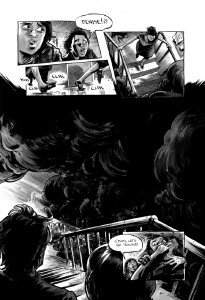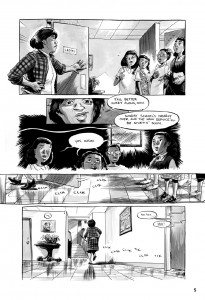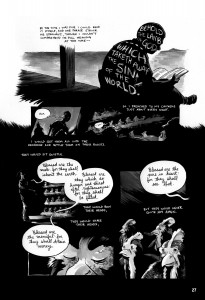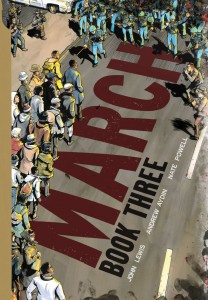 Welcome to Using Graphic Novels in Education, an ongoing feature from CBLDF that is designed to allay confusion around the content of graphic novels and to help parents and teachers raise readers. In this column, we examine graphic novels, including those that have been targeted by censors, and provide teaching and discussion suggestions for the use of such books in classrooms.
Welcome to Using Graphic Novels in Education, an ongoing feature from CBLDF that is designed to allay confusion around the content of graphic novels and to help parents and teachers raise readers. In this column, we examine graphic novels, including those that have been targeted by censors, and provide teaching and discussion suggestions for the use of such books in classrooms.
In this post we take a closer look at March: Book Three by John Lewis, Andrew Aydin, and Nate Powell (Top Shelf, 2016).March: Book Three brilliantly and sensitively concludes Representative John Lewis’ story while documenting Americans’ struggle for equal rights and civil liberties. Through all three volumes of March, readers read, see, and feel those struggles first hand. Furthermore, while each part of the trilogy tells a continuing story, that they each can equally stand on their own as solid stories and historical resources. Alone and together, these three volumes relay the struggles, the pains, and the hopes of Black and White Americans in the early 1960s, while highlighting some of this country’s greatest modern heroes.
March: Book Three is the final volume of Rep. John Lewis’s graphic novel memoir trilogy, co-written with his aide Andrew Aydin and illustrated by Nate Powell. Since its publication, the book has won numerous awards. March: Book Three won the Coretta Scott King Book award recognizing an African-American author and illustrator of outstanding books for children and young adults; the Michael L. Printz Award for excellence in literature written for young adults; the Robert F. Sibert Informational Book Award for the most distinguished informational book for children; and the YALSA Award for excellence in nonfiction for young adults. March: Book Three also won the National Book Award — the first time a graphic novel took this coveted award (although others have been shortlisted, including Gene Luen Yang’s American Born Chinese and Boxers and Saints, David Small’s Stitches, and Noelle Stevenson’s Nimona). The book is also a #1 New York Times bestseller, winner of the Walter Dean Myers Award for Outstanding Children’s Literature (Young Adult Category), finalist for the LA Times Book Prize, and an Eisner Award winner. Finally, it received starred reviews from Kirkus Reviews, Booklist, School Library Journal, The Horn Book, Library Journal, and Publishers Weekly.
In addition to these prestigious awards and recognition, March has been adopted into core curricula across the country. March is now used in San Francisco schools and in New York City schools, where it is read by all 8 graders as part of their American history curriculum. Atlanta schools are now using it in their seventh-grade language arts courses.
Please visit our previous posts detailing instructional guidance March: Book One and March: Book Two.
March: Book Three opens with the bombing of the 16th Street Baptist Church at the hands of the Ku Klux Klan, which claimed the lives of four young girls. As the book unfolds, we read about Lewis’ involvement in Bloody Sunday as well as his public work and private experiences leading up to The 1965 Voting Rights Act, which closes the book (aside from an epilogue depicting President Obama’s inauguration in 2009 and mirroring the opening of the trilogy).
The storytelling and its emotionally packed panels make this volume and the entire series essential reading for middle school students and up as they learn understand this critical and tumultuous time in American history.
Overview
March: Book Three, begins with the September 1963 bombing of the 16th Street Baptist Church (and the subsequent riots) and ends with the 1965 Voting Rights Act being signed into legislature. Throughout Book Three we learn about the Civil Rights Movement from 1963-1965 and John Lewis’ role in it as chair of the SNCC (Student Nonviolent Coordinating Committee), as a speaker, and as an activist in various marches and innovative projects such as the Freedom Vote, the Mississippi Freedom Summer, the Democratic National Convention and more.
In short, Book Three is about the SNCC’s efforts to register African-American citizens to vote. While we today often take this patriotic act for granted, the creators relate just how challenging it was, and how many Americans gave their time and even their lives to secure this right. In this volume, Lewis relates what he believed to be the critical turning point in the Civil Rights Movement and why the SNCC eventually fractured.
More specifically, through Lewis’ recollections, through excerpts of famous speeches and quotes and through the genius of Aydin’s direction and Powell’s art, we literally become active viewers as the following events unfold:
- the bombing of the 16th Street Baptist Church in Birmingham, Alabama;
- Freedom Day, October 7, 1963;
- mock election in Mississippi, 1963;
- Freedom Vote;
- Mississippi Freedom Summer;
- the creation of the Mississippi Freedom Democratic Party;
- Republican National Convention, July 1964;
- Democratic National Convention, August 1964;
- the Project for Alabama Freedom Movement;
- Dr. King’s Nobel Peace Prize;
- Teacher’s March in Selma, Alabama;
- the march from Selma to Montgomery;
- Bloody Sunday; and
- the 1965 Voting Rights Act;
In Book Three, in addition to reading about the volatile events from 1963-1965, we meet some wonderful and not-so-wonderful people. Civil Rights leaders highlighted in this volume include:
- Joe Rauh, attorney for MFDF (Mississippi Freedom Democratic Party);
- Fanny Lou Hamer, MFDF Vice-chair and pivotal figure at the Democratic National Convention;
- Nelson Rockefeller, Governor of New York and speaker at the Republican National Convention;
- President Johnson;
- Harry Belafonte; and
- Malcolm X.
March: Book Three is beautifully written and illustrated. As in the previous two volumes, we read, see and feel, the tension in the South and in Washington as events unfold. The interplay of language, art and design (choice of panel, font and use of space) make the story come alive. We, as readers, literally feel like we are there, observing, hurting, feeling, and cheering on our heroes. Through the use of visual and verbal metaphor, narrative, dialogue, snippets from famous quotes and speeches, the story feels real, personal, and meaningful as these three authors make this tumultuous period in our history come alive.
In March: Book Three (as in the previous volumes) black and white images empower viewers to comprehend those volatile times as we intimately view Lewis’ recollection of unfolding events. Powell’s black and white contrasting, sharp angles, and brilliant page design and fonts are all used to relay violent emotions. This is then paired and contrasted with soft, sloping grays for the gentler intervals. We see Black and White protesters treated with equal respect and drawn with soft rounded strokes, while White Southern agitators and Ku Klux Klan members are drown in chilling, brutal, angular strokes. There are beautiful wide-angle shots establishing historic locations, and sharp, angular, lines along with extensive use of black and white color juxtapositions to relate Lewis’ personal turmoil and the drama of these famous and infamous events. Lewis, Aydin, and Powell relay the story in visual and verbal metaphors that are breathtaking.
What makes this book and this series so outstanding is that while Lewis tells his side of the Civil Rights Movement, he modestly downplays his own role as we learn that the real heroes were those who sacrificed their personal goals, their time, and often their lives to advancing equal rights for all. As a result we feel like we are there with them, looking on, urging them forward.
Here is a more detailed look.
Lewis’ Story In March: Book Three
Regardless of whether we’re in 2017 or the heat of the 1960’s, Lewis continues to tell his story in his engaging first-person narrative – either from his eyewitness accounts or through his recollections of where he was when critical events unfolded.
As Lewis’ life unfolds in March: Book Three, we learn about the tragic bombing of the 16th Street Baptist Church on September 15, 1963, during which four young girls were murdered. Fear gripped Birmingham as riots erupted, resulting in even more tragic deaths. Following the bombing and the funerals, we learn that Diane Nash and Lewis met with Dr. King to present a plan. Their “Action in Montgomery” proposed they recruit a nonviolent army to “pour into the capital city” in the hopes of shutting it down until the following objectives were met: force Governor George Wallace out of office and allow every adult in Alabama a vote. We learn that while Dr. King didn’t approve of the plan, the SNCC still went ahead to register Black voters in Selma (Alabama).
This turned out to be no easy feat. There was “Freedom Day” on October 7,1963, during which a large mobilization of African-Americans waiting to register to vote met intense resistance. Few were allowed into buildings to register and many met with various ways made to stop them. It’s noted (pages 31-32) that, “In some places African-Americans were asked to count the number of jelly beans in a jar, or the number of bubbles in a bar of soap… literacy tests… filled with questions meant to trip up even the smartest person…Even if a Black citizen were able to register, their name would be printed in the local paper — making them a target…”
This resistance, along with multiple arrests and violence from the hands of Alabama State Troopers (incited by Sheriff Clark), meant the task of voter registration became quite difficult. The project, however, continued to expand. It expanded to the State of Mississippi, it expanded to mock elections to help teach African-Americans how to register and vote, and it expanded to the Freedom Vote movement. Tragically, three volunteers were murdered as they traveled from their training — murders that Neshoba County officials denied for a long time.
Lewis’ story takes us from the establishment of the MFDP to the role it played in the Republican and Democratic National Conventions. More specifically, to its role in trying to have its own delegates admitted to the Democratic National Convention, as Alabama refused to allow them a voice (let alone votes).
At the convention, we learn of Joe Rauh’s role in helping the MFDP, and his having various testimonies of people like Fannie Lou Hamer (who’d been beaten previously for her attempt to gain the vote) aired on national television — with the hopes of adding continued pressure on Johnson and Humphrey — the Democratic candidates for President and Vice President. The remainder of the book recounts the pivotal events at the Democratic National Convention, and the roles played by leaders such as President Johnson, Dr. King, Malcolm X and others, all leading to Johnson’s signing the 1965 Voting Rights Act on August 6, 1965.
The SNCC established a volunteer training program where White and Black volunteers were trained on how to get Black voters to register. This was done during “Freedom Summer.” Their goal was to set up Freedom Schools in local churches and community centers and to register voters on mock polling lists. In April 1963, the Mississippi Freedom Democratic Party (MFDP) was officially created.
In short, Lewis’ story is told through gentle narration and vibrant art in a way that empowers us to relive it with him. As a result, readers better understand the social unrest of 1960s, the trials and tribulations of brave Black and White Americans who offered their time and many their lives for the Civil Rights Movement, and the torturous route that had to be taken to secure the rights of every American adult to vote.
TEACHING/DISCUSSION SUGGESTIONS: For Social Studies and/or for Black History Month
- Chart the progress of the Civil Rights Movement through this book or this series.Discuss
- The choices and objectives the characters made and how each one influenced their paths.
- What was gained and what was lost? What were the costs to states/cities/individuals?
- What were the pivotal decisions made that helped shape the changing political and social landscapes?
- Different ways people (newspapers, magazines, personal accounts) reacted and reported major civil rights incidents, marches, deaths, etc.
- Research the speeches made by:
- Nelson Rockefeller at the 1964 Republican National Convention;
- Dr. King at rallies and his letter from prison;
- John Lewis at various churches and rallies;
- Fannie Lou Hamer’s testimony aired on television from the Democratic National Convention;
- President Johnson at the death of President Kennedy, at the Democratic National Convention, and upon signing the 1965 Voting Rights Act. Discuss how his views, policies, and convictions changed or didn’t change.
- Research, present, and discuss the lives and roles of the Civil Rights Movement leaders mentioned in this book:
- Dr. Martin Luther King, Jr.,
- Joe Rauh;
- Malcolm X;
- Fannie Lou Hamer;
- Diane Nash;
- Rosa Parks;
- Bob Moses;
- Al Lowenstein;
- Mickey Schwerner (and his surviving wife Rita), Andy Goodman, and James Chaney — the three Freedom Vote volunteers murdered in Neshoba County.
- Research, present and discuss the lives and roles of those who fought the Civil Rights Movement:
- Alabama Governor George Wallace, Jr.;
- Jim Clark, Sheriff of Dallas County, Alabama.
- Research, present and discuss the different ‘sides’ of the following events. Discuss how each shaped and affected the world around them:
- The Freedom Vote;
- The Freedom Summer;
- The Teachers’ March in Dallas County, Alabama;
- The Civil Rights Act of 1964;
- The 1965 Voter Rights Act;
- The 1964 Republican and Democratic Conventions.
Cultural Diversity, Civic Responsibilities, and Social Issues
- Analyze how the book’s different characters dealt with racism. Ask students how they might deal with racist comments, practices and restrictions.
- Discuss different options and means of protest. How have these options changed today compared to the options Lewis and his colleagues had in the 1960s?
- Define and discuss racism.
- Discuss the different instances of discrimination and racism presented throughout the book. Discuss instances of racism today on local, national, and international scenes.
- How is it the same/different across time and geographic locations (nationally and/or internationally)?
- How, has racism changed today, if at all?
- Discuss how hurtful racism can be to those targeted as well as to the general population.
- Discuss how racism has influenced, shaped, and determined national and international policies and politics.
- Discuss what can be done today to fight racism and discrimination and ways students can help.
- Throughout the book, Lewis relays discussion among the leaders of SNCC and others regarding White volunteers and the need to develop Black leadership. On page 53, Bob Moses notes that, “We cannot do this alone. The ONLY way this can work is to have White people working alongside …so it isn’t Negro fighting White — it’s a question of rational people against irrational people.”
- Debate the pros and cons and integrating White and Black leaders and demonstrators;
- Analyze and discuss the urgency to develop Black leadership and the problems they faced in doing that.
- On page 63, Lewis speaks publically saying, “…Registering to vote is an act of commitment to the American ideal. It is patriotic. The federal government must decide whether it wants to let southern Negroes register. It must make that choice this summer — or make us all witnesses to the lynching of democracy.” Debate and discuss:
- What Lewis means by implying the denial of Black right to vote is a “lynching of democracy.” Discuss his choice of words as well as the intent behind them;
- Why the rights for all adult voters were so critical to the Civil Rights Movement as well as for this country in general. Why was there so much opposition?
Language, Literature, and Language Usage
- Search for, define, and discuss the book’s use idioms, hyperbole and simile to better express opinions, feelings and cultural expressions. Discuss how effective they are in communicating a specific message or a specific point in time.
- Compare and contrast the language used in the various speeches given by President Johnson from the time he took office at the death of President Kennedy to his announcement of the 1965 Voter Rights Act. How did his tone and words change?
- Have students collect family stories (oral, written, and/or photographed) of the 1960s and Civil Rights Movement, marches, and protests, and/or stories of racism and segregation. [Note there were and still are incidents of racism and segregation experienced by minority and immigrant families. To include all your students, you may want to expand your discussion/project to examine racist incidents directed at various groups.]
- You may have students write two versions of these stories as a means of reflecting on language use and idioms that are time/era specific. Have them write first-person narrative as if they are in the 1960s; and then have them write about the era in reflection. How do the language and/or the story differ?
Critical Thinking and Inferences – the authors make many inferences in this book both with language use and through imagery. You may want to discuss the following uses of inference:
- On page 18, Lewis recalls “…Governor George Wallace had started his term declaring ‘Segregation Forever,’ and two weeks before the bombing [at 16th Street Baptist Church], he was quoted in the paper saying, ‘What this country needs is a few first-class funerals.” Discuss:
- What Wallace meant and why he felt this way;
- How might you as a community respond to a statement like this;
- Would someone today say this — why or why not?
- On page 52 we are privy to an SNCC discussion on how “President Kennedy’s death brought our deepest fears to the forefront.” The SNCC reactions included sadness, concern for their field staff (“…if the President can be killed, then they don’t stand a chance…”). One member goes so far as to wonder, “Will they think that liberalism is dead when the man is dead?”. Discuss:
- Different reactions around the country after President Kennedy’s death (researching newspapers and video/news clips) versus the SNCC reactions as depicted in this book;
- Discuss “Will they think that liberalism is dead when the man is dead?” Who are “they” and what are the meanings and ramifications of this statement?
- On page 54, we read that President Johnson “…moved quickly on his promise to pass a civil rights bill. Unfortunately, that meant pressuring many civil rights groups, the SNCC included, to halt our protests and demonstrations — He felt our actions were making it harder for him to win votes in congress. We strongly disagreed.” Have students debate both sides.
- On page 118 Fannie Lou Hamer is watching recaps of her testimony earlier that day at the Democratic National Convention and she notes to her companions, “That’s why I like that song “Go Tell It On the Mountain…’ I feel like I’m talking to the world.” Discuss what she meant by this. Discuss the power of song to move people and to shape movements and policy.
- On page 124 Lewis notes, “To me the 1964 Democratic Convention was the turning point in the [Civil Rights] Movement.” Discuss and debate what he meant and why he may have felt this way. Do you and your students agree? Why / why not?
Modes of Storytelling and Visual Literacy
In graphic novels, images are used to relay messages with and without accompanying text, adding additional dimension to the story. Aydin and Powell are masters at having text, image, shading and design work in harmony to communicate passions, events, and powerful messages. Compare, contrast, and discuss with students how images can be used to relay complex messages. Here lesson suggestions to help students learn and appreciate this skill:
- Have students hunt for examples of how Aydin and Powell use text, image and design to relay complicated messages and issues, or simply present your own instances and have students analyze them.
- Discuss how seemingly effortlessly the transitions are made between past and present. Analyze how this is done.
- Compare and contrast the depiction of violence (for example on pages 7-10; 12-13; 34-35; 40; 94-95; 151-157; 164-165; 200-205).
- Analyze and discuss the visual metaphor on page 79. They are concerned about three missing Freedom Vote volunteers. We read the text, “We felt so powerless… a small band set out to search…” while we see someone searching in the dark with a flashlight, a mosquito biting hi then him killing the mosquito before continuing with his search, shining a flashlight on a patch of grass.
- Analyze the spread on pages 116-117. On one side of the page we see a peaceful empty parking lot at the Democratic National Convention. There are two White men walking into the lot and some puffy white clouds to the left of this page. On page 117 we see the burnt-out car in which the three murdered Freedom Vote volunteers had been traveling. It is clearly burnt, there is a large burnt cross coming out of its remains (with a dove or white bird perched on top), and three signs: “Seat the Freedom Democratic Party” “MISS Klan Response to Negro Vote Drive” and “Talk About Us on the Floor.”
- Discuss your reactions to this image — both immediate reactions and subsequent reactions after closer looks.
- Discuss the intent of these two pages.
- Discuss the signs displayed.
- Discuss what makes this image and its message so powerful.
- Analyze and discuss the top panel on page 121. The text notes that, “Meanwhile, Johnson’s people were working in back channels… to erode our support on the credentials committee [at the Democratic National Convention]…” This text, however, is juxtaposed on a black background with an image of an old phone with phone cords twisted and locked around dialogue balloons from their various conversations.
Suggested Supplemental Reading
For greater discussion on literary style and/or content here are some prose novels and poetry you may want to read with March: Book Three
- March Books One and March: Book Two
- Kingby Ho Che Anderson (Fantagraphics, 1993; reprint edition 2010): a beautifully illustrated award-winning biography integrates interviews, narrative, sketches, illustrations, photographs and collages that pieces together an honest look at the life, times, tragedies, and triumphs of Martin Luther King Jr. For King, Anderson won Harvey Awards for Best New Talent (1991); Best Graphic Album (1993); and Parents’ Choice Award (1995).
- The Silence of Our Friends by Mark Long, Jim Demonakos, and Nate Powell (First Second Books, 2012): a semi-autobiographical story of Mark Long’s childhood experiences in Houston, Texas, during 1968 and centering around the Texas Southern University student boycott after the Student Nonviolent Coordinating Committee (SNCCC) was banned from its campus.
- P.S. Be Eleven (winner of the Loretta Scott King Award, 2013) and sequel to One Crazy Summer (Newbery Honor Book) by Rita Williams-Garcia: addressing race, gender, and political issues of the late 1960s.
- Martin’s Big Words: The Life of Dr. Martin Luther King Jr. by Doreen Rappaport and Bryan Collier (illustrator): an extraordinary picture-book biography incorporating narrative, famous quotes from Dr. King, and powerful collage and watercolor illustrations introducing King’s words and legacy to younger readers.
- Everybody Says Freedom: A History of the Civil Rights Movement in Songs and Pictures by Pete Seeger and Bob Reiser (W.W. Norton, 1990)
Common Core State Standards
March: Book Three is full of advanced vocabulary, simile, slang, idioms, and oratory. It promotes critical thinking, introduces multiple national American heroes, and is a coming of age story laden with issues of identity, justice and friendship. Furthermore, in graphic novel format, it provides verbal and visual story telling that addresses multi-modal teaching, and meets Common Core State Standards. As this book can and should be used by students in middle grades through high school, we relate below how it meets the Common Core Anchor Standards:
- Knowledge of Language: Apply knowledge of language to understand how language functions in different contexts, to make effective choices for meaning or style, to comprehend more fully when reading or listening.
- Vocabulary Acquisition and Use: Determine or clarify the meaning of unknown and multiple-meaning words and phrases by using context clues, analyzing meaningful word parts, and consulting general and specialized reference materials; demonstrate understanding of figurative language, word relationships, and nuances in word meaning; acquire and use accurately a range of general academic and domain-specific words and phrases sufficient for reading, writing, speaking and listening at the college and career readiness level.
- Key ideas and details: Reading closely to determine what the texts says explicitly and making logical inferences from it; citing specific textual evidence when writing or speaking to support conclusions drawn from the text; determining central ideas or themes and analyzing their development; summarizing the key supporting details and ideas; analyzing how and why individuals, events, or ideas develop and interact over the course of the text.
- Craft and structure: Interpreting words and phrases as they are used in a text, including determining technical, connotative, and figurative meanings and analyzing how specific word choices shape meaning or tone; analyzing the structure of texts, including how specific sentences, paragraphs and larger portions of the text relate to each other and the whole; Assessing how point of view or purpose shapes the content and style of a text.
- Integration of knowledge and ideas: Integrate and evaluate content presented in diverse media and formats, including visually…as well as in words; delineate and evaluate the argument and specific claims in a text, including the validity of the reasoning as well as the relevance and sufficiency of the evidence; analyze how two or more texts address similar themes or topics in order to build knowledge or to compare the approaches the authors take
- Range of reading and level of text complexity: Read and comprehend complex literary and informational texts independently and proficiently
- Research to Build and Present Knowledge: Conduct short as well as more sustained research projects based of focused questions, demonstrating understanding of the subject under investigation; gather relevant information from multiple print and digital sources, assess the credibility and accuracy of teach source, and integrate the information while avoiding plagiarism; draw evidence from literary or informational texts to support analysis, reflection, and research.
- Comprehension and collaboration: Prepare for and participate effectively in a range of conversations and collaborations with diverse partners, building on others’ ideas and expressing their own clearly and persuasively; integrate and evaluate information presented in diverse media and formats, including visually, quantitatively and orally; evaluate a speaker’s point of view, reasoning, and use of evidence and rhetoric.
- Presentation of knowledge and ideas: Present information, findings, and supporting evidence such that listeners can follow the line of reasoning and the organization; adapt speech to a variety of contexts and communicative tasks, demonstrating command of formal English when indicated or appropriate.
This book and related discussions also cover the following themes identified by The National Council for the Social Studies:
- Culture and Cultural Diversity – “…students need to comprehend multiple perspectives … to consider the strengths and advantages that this diversity offers to the society in general and to their own growth…to analyze the ways that a people’s cultural ideas and actions influence its members…”
- Time, Continuity, and Change – “…facilitate the understanding and appreciation of differences in historical perspectives and the recognition that interpretations are influenced by individual experiences, societal values, and cultural traditions… examine the relationship of the past to the present and extrapolating into the future… provide learners with opportunities to investigate, interpret, and analyze multiple historical and contemporary viewpoints within and across cultures related to important events, recurring dilemmas, and persistent issues, while employing empathy, skepticism, and critical judgment…”
- Individual Development and Identity – “…describe how family, religion, gender, ethnicity, nationality, socioeconomic status, and other group and cultural influences contribute to the development of a sense of self…have learners compare and evaluate the impact of stereotyping, conformity, acts of altruism, discrimination, and other behaviors on individuals and groups…”
- Individuals, Groups, and Institutions – “…help learners understand the concepts of role, status, and social class and use them in describing the connections and interactions of individuals, groups, and institutions in society…analyze groups and evaluate the influence of institutions, people, events, and cultures in both historical and contemporary settings…identify and analyze examples of tensions between expressions of individuality and efforts of groups and institutions to promote social conformity…”
- Power, Authority, and Governance – “…understanding the historical development of structures of power, authority, and governance and their evolving functions in contemporary American society… enable learners to examine the rights and responsibilities of the individual in relation to their families, their social groups, their community, and their nation… examine issues involving the rights, roles, and status of individuals in relation to the general welfare…explain conditions, actions, and motivations that contribute to conflict and cooperation within and among nations…challenge learners to apply concepts such as power, role, status, justice, democratic values, and influence…”
- Civic Ideals and Practices – “…assist learners in understanding the origins and continuing influence of key ideals of the democratic republican form of government, such as individual human dignity, liberty, justice, equality, and the rule of law…analyze and evaluate the influence of various forms of citizen action on public policy…evaluate the effectiveness of public opinion in influencing and shaping public policy development and decision-making…”
ADDITIONAL RESOURCES:
- https://snccdigital.org/inside-sncc/alliances-relationships/mfdp/ — From the SNCC digital collection: “Mississippi Freedom Democratic Party (MFDP) – photos and background information.
- http://www.jsums.edu/hamerinstitute/resources/flhspeeches/ — A Voice That Could Stir an Army: Fannie Lou Hamer and the Rhetoric of the Black Freedom Movement – has various texts and speeches made my Fannie Lou Hamer. These are in text format and some video/recorded speeches.
- http://crdl.usg.edu/events/freedom_summer/?Welcome — (The Digital speeches on Library of Georgia, part of the GALILEO Initiative) Freedom Summer – contains background information, archival collections and reference resources, educator resources
- http://www.pbs.org/wgbh/americanexperience/films/freedomsummer/ — PBS.org American Experience: Freedom Summer – has a brief synopsis of the Mississippi Freedom Summer initiative; Clips “An Integrated Party” about the Democratic National Convention; “Three Missing Workers”; “The Risk” discussing the risks volunteers took in Mississippi that summer; “Fannie Lou Hamer’s Testimony”, about the testimony before the Democratic Credentials Committee and President Johnson’s impromptu press conference to get her off the air; “How Many Beatings Have you Taken?” Fannie Lou Hamer’s testimony before Mississippi Democrats; “The Eulogy” Dave Dennis’ eulogy at the funeral of James Chaney, one of the three Freedom Vote volunteers killed in the summer of 1964; “Searching for the Bodies” )”I think it’s a hoax but If they dead I think they asked fo’ it”… one White woman says; “Pete Seeger and Freedom Summer”; and much more.
- http://www.history.com/topics/Black-history/freedom-summer/videos/sound-smart-the-voting-rights-act-of-1965 — Smart Sound: The Voting Rights Act of 1965 – two minute video sponsored by History.com and historian Yohuru Williams
- https://www.youtube.com/watch?v=xbuSZTfLubY— Lyndon Johnson’s Democratic Convention Acceptance Speech (YouTube)
- http://www.jofreeman.com/photos/mfdp64.html — The Civil Rights Vigil at the 1964 Democratic Convention – includes a discussion of that event and photographs including the one of the burnt out car that had carried the three murdered Freedom Vote volunteers.
- http://www.vogue.com/article/celebrating-fannie-lou-hamer-1964-dnc — celebrating Fannie Lou Hamer, Heroine of the 1964 Democratic National Convention.
- PBS’ American Experience: Civil Rights Movement Non-Violent Protests — contains related videos, photographs, interviews, press coverage and primary sources, milestones, reflections, notes for teachers, and more.
- http://www.loc.gov/teachers/classroommaterials/themes/civil-rights/exhibitions.html — multimedia resources from the Library of Congress that support the teaching about civil rights
- Historical places of the Civil Rights Movement – We Shall Overcome: A National Register of Historic Places Travel Itinerary with an introduction, itinerary maps, list of sites and links to learn more.
- http://www.academicinfo.net/africanamcr.html — civil rights history resource.
- http://www.pbs.org/teachers/thismonth/civilrights/index1.html — teaching ideas for the Civil Rights Movement in American literature (all grade levels)
- http://www.crmvet.org/poetry/poemhome.htm — poems of the Freedom Movement
- Notes and brochures of the SCLC’s Crusade for Citizenship found now at the King Center.
- A guide for students on how to conduct oral history interviews with samples of American slave narratives and other primary resource sets
- http://www.history.com/search?q=civil+rights+movement&x=0&y=0 — History Channel list of links and resources
- http://www.goodreads.com/shelf/show/civil-rights-movement and http://www.slj.com/2013/01/books-media/collection-development/focus-on-collection-development/civil-rights-everyday-heroes-focus-on-january-2013/ — provides extensive lists for further reading on the Civil Rights Movement for students of varying ages and reading levels.
Meryl Jaffe, PhD teaches visual literacy and critical reading at Johns Hopkins University Center for Talented Youth Online Division and is the author of Raising a Reader! and Using Content-Area Graphic Texts for Learning. She used to encourage the “classics” to the exclusion comics, but with her kids’ intervention, Meryl has become an avid graphic novel fan. She now incorporates them in her work, believing that the educational process must reflect the imagination and intellectual flexibility it hopes to nurture. In this monthly feature, Meryl and CBLDF hope to empower educators and encourage an ongoing dialogue promoting kids’ right to read while utilizing the rich educational opportunities graphic novels have to offer. Please continue the dialogue with your own comments, teaching, reading, or discussion ideas at meryl.jaffe@cbldf.org and please visit Dr. Jaffe at http://www.departingthe text.blogspot.com.
All images (c) John Lewis, Andrew Aydin, and Nate Powell.
Help support CBLDF’s important First Amendment work in 2017 by visiting the Rewards Zone, making a donation, or becoming a member of CBLDF!
